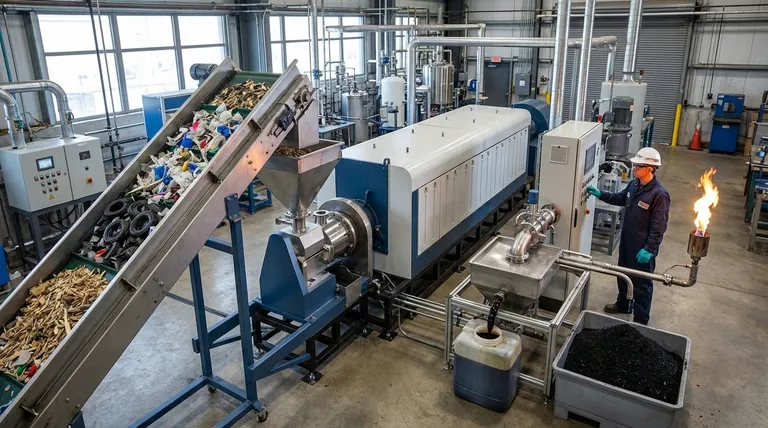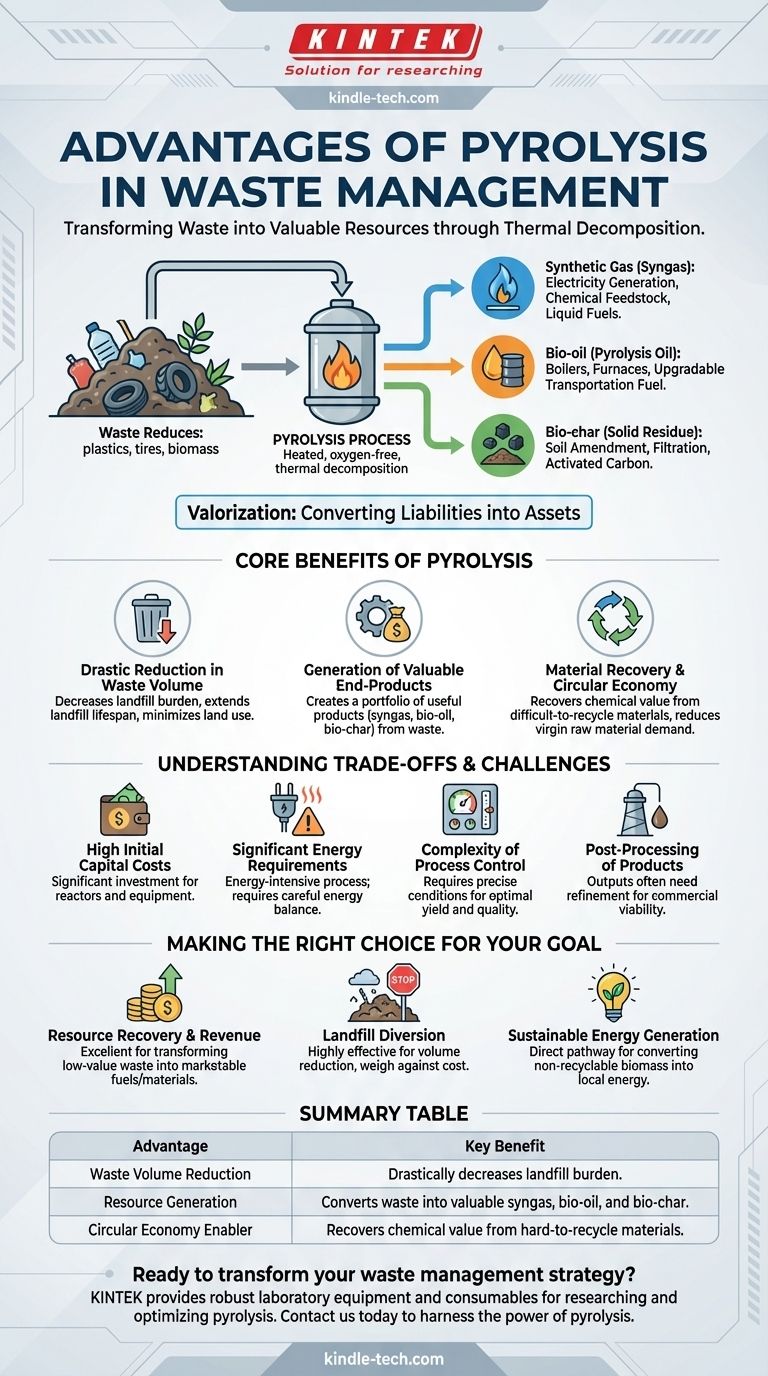At its core, pyrolysis is a powerful method for waste management that significantly reduces landfill volume while simultaneously creating valuable resources. This thermal decomposition process heats waste materials like plastics, tires, and biomass in an oxygen-free environment, breaking them down into useful outputs such as synthetic gas (syngas), bio-oil, and a solid residue called bio-char.
The primary advantage of pyrolysis is its ability to reframe waste from a disposal problem into a resource opportunity. It is a technology of valorization, converting liabilities into assets like fuel and industrial materials.

The Core Benefits of Pyrolysis
Pyrolysis offers a multi-faceted approach to waste, addressing environmental, economic, and resource management goals simultaneously. Its benefits extend far beyond simple volume reduction.
Drastic Reduction in Waste Volume
The most immediate advantage is the dramatic decrease in the sheer volume of waste requiring disposal. By converting the bulk of solid waste into gas, liquid, and a smaller solid fraction, pyrolysis drastically reduces the burden on landfills.
This extends the lifespan of existing landfills and minimizes the need to acquire new land for waste disposal, a significant environmental and economic challenge for many communities.
Generation of Valuable End-Products
Unlike incineration, which primarily produces heat and ash, pyrolysis creates a portfolio of useful products. This process effectively converts waste into new raw materials.
- Syngas: A mixture of hydrogen and carbon monoxide that can be combusted to generate electricity or serve as a feedstock for producing chemicals and liquid fuels.
- Bio-oil: A liquid fuel, also known as pyrolysis oil, that can be used in boilers and furnaces or be upgraded into higher-quality transportation fuels.
- Bio-char: A stable, carbon-rich solid that can be used as a soil amendment to improve fertility, as a filtration medium, or as a feedstock for producing activated carbon.
Material Recovery and a Circular Economy
Pyrolysis is a key enabler of a circular economy. It provides a method to recover the chemical value locked within materials like plastics and rubber that are difficult to recycle mechanically.
By breaking these materials down into their constituent components, pyrolysis reduces the demand for virgin raw materials. This lessens the environmental impact associated with extraction and processing, such as oil drilling for new plastics.
Understanding the Trade-offs and Challenges
While powerful, pyrolysis is not a universally perfect solution. A clear-eyed assessment of its limitations is critical for any serious evaluation.
High Initial Capital Costs
Pyrolysis facilities represent a significant financial investment. The reactors, control systems, and associated equipment for handling feedstock and end-products require substantial upfront capital.
Significant Energy Requirements
The process is energy-intensive, as it requires heating large volumes of waste to high temperatures. A plant's net energy output must be carefully calculated to ensure it is a net energy producer after accounting for its own operational needs.
Complexity of Process Control
Efficiency is highly dependent on precise process conditions. Maintaining an oxygen-free atmosphere and a consistent temperature profile is crucial for maximizing the yield of desired products and avoiding the creation of unwanted byproducts.
Post-Processing of Products
The raw outputs of pyrolysis often require further refinement to be commercially viable. Bio-oil may need stabilization and upgrading, and syngas may need cleaning to remove impurities before it can be used in engines or turbines, adding cost and complexity.
Making the Right Choice for Your Goal
The decision to implement pyrolysis should be driven by specific strategic objectives. It is a versatile tool, but its value proposition changes depending on your primary goal.
- If your primary focus is resource recovery and revenue: Pyrolysis is an excellent choice for transforming low-value waste streams into marketable fuels and materials.
- If your primary focus is landfill diversion: Pyrolysis is highly effective at volume reduction, but its high capital cost must be weighed against simpler, less expensive technologies.
- If your primary focus is sustainable energy generation: Pyrolysis offers a direct pathway to convert non-recyclable biomass and plastics into local sources of energy, enhancing energy independence.
Ultimately, adopting pyrolysis marks a strategic shift from simple waste disposal to integrated resource management.
Summary Table:
| Advantage | Key Benefit |
|---|---|
| Waste Volume Reduction | Drastically decreases landfill burden and extends landfill lifespan. |
| Resource Generation | Converts waste into valuable syngas, bio-oil, and bio-char. |
| Circular Economy Enabler | Recovers chemical value from hard-to-recycle materials like plastics. |
Ready to transform your waste management strategy with pyrolysis technology?
KINTEK specializes in providing robust laboratory equipment and consumables to help you research, develop, and optimize pyrolysis processes. Whether you're focused on resource recovery, landfill diversion, or sustainable energy generation, our solutions support your goals for a more efficient and profitable operation.
Contact us today via our [#ContactForm] to discuss how our expertise can help you harness the power of pyrolysis and turn waste liabilities into valuable assets.
Visual Guide

Related Products
- Electric Rotary Kiln Small Rotary Furnace Biomass Pyrolysis Plant
- Electric Rotary Kiln Pyrolysis Furnace Plant Machine Calciner Small Rotary Kiln Rotating Furnace
- Electric Rotary Kiln Continuous Working Small Rotary Furnace Heating Pyrolysis Plant
- Customizable High Pressure Reactors for Advanced Scientific and Industrial Applications
- Vacuum Sealed Continuous Working Rotary Tube Furnace Rotating Tube Furnace
People Also Ask
- What is the process of biomass fast pyrolysis? Turn Biomass into Bio-Oil in Seconds
- What are the conditions for biomass pyrolysis? Optimize Temperature, Heating Rate & Time
- What are the advantages of pyrolysis technology? Turn Waste into Profit and Reduce Emissions
- What are the components of biomass pyrolysis? A Complete Guide to the System, Products, and Process
- Is pyrolysis viable? A Guide to Economic, Technological, and Environmental Success



















